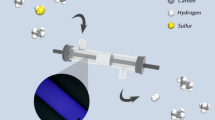Abstract
Atmospheric Pressure Dielectric Barrier Discharge (APDBD) initiated decomposition of CO2 and C6–C9 alkanes (in Ar carrier) with uncoated and TiO2/ZnO coated glass surfaces, and under molecular sieve 10 X packing are presented in this study. Alkanes employed include 2-methylpentane, cyclohexane, n-hexane, n-heptane, n-octane, n-nonane and their decomposition products studied include C1–C3 hydrocarbons viz. CH4, C2H4, C2H6 and C3H8. Generally the yields of all these C1–C3 products increased with discharge energy, however to a major extent the parent alkane structure controlled the relative concentration profiles of the individual products. Typically the slopes of the increase in various products yield varied from 0.025 to 0.25 ppm (v/v) mm V−1. However, in the case of cyclohexane the total yield of methane, ethane and propane were only ∼20% of ethylene yield. Use of TiO2 as well as TiO2/ZnO coated central glass electrode in the APDBD apparatus showed ∼11% enhancement in \( \hbox{CO}_{2} \rightarrow \hbox{CO} \) degradation efficiency. However, while overall 2-methylpentane decomposition reduced significantly to ∼30%, in case of n-octane its decomposition to the C1–C3 products remained unaffected. On the other hand under molecular sieve 10X packing, yield of CH4 and C2H4 increased significantly in both cases.



Similar content being viewed by others
References
Dey GR, Das TN (2006) Plasma Chem Plasma Process 26:495
Dey GR, Ganguly R, Das TN (2006) Plasmonics 2:95
Inui T, Takeguchi T (1991) Catal Today 10:95
Eliasson B, Simon F-G, Egli W (1992) Hydrogenation of CO2 in a silent discharge. ABB Corporate Research Report CRB-92-002 C. Baden-Dattwil
Eliasson B, Simon F-G, Egli W (1992) In: Proceedings of the NATO advanced research workshop on non-thermal plasma techniques for pollution control. Cambridge.
Eliasson B, Simon F-G, Egli W, Brunner P (1992) Helv Phys Acta 65:129
Egli W, Eliasson B (1992) Helv Phys Acta 65:127
Eliasson B, Egli W, Kogelschatz U (1994) Pure Appl Chem 66:1275
Kogelschatz U (2003) Plasma Chem Plasma Process 23:1
Kogelschatz U (2002) IEEE Trans Plasma Sci 30:1400
Kraus M, Egli W, Haffner K, Eliasson B, Kogelschatz U, Wokaun A, (2002) Phys Chem Chem Phys 4:668
Gellert B, Kogelschatz U (1991) Appl Phys B 52:14
Matsumoto H, Tanabe S, Okitsu K, Hayashi Y, Suib SL (1999) Bull Chem Soc Jpn 72:2567
Gentile AG, Kushner MJ (1996) Appl Phys Lett 68:2064
West RC (1984–85) CRC press handbook of chemistry and physics, 65th edn. D-199. CRC Press, Boca Raton, FL
Mills A, Le Hunte S (1997) J Photochem Photobiol A:Chem 108:1
Kamat PV (1993) Chem Rev 93:267
Hoffman MR, Martin ST, Choi W, Bahnemann DW (1995) Chem Rev 95:69
Fujishima A, Rao TN, Tryk DA (2000) J Photochem Photobiol C:Photochem Rev 1:1
George JK (1993) Fundamentals of photoinduced electron transfer. VCH Publishers Inc, NY, p 259
Acknowledgements
We thank our colleagues in Radiation and Photochemistry Division and in Analytical Chemistry Division for their support during the course of this study.
Author information
Authors and Affiliations
Corresponding author
Rights and permissions
About this article
Cite this article
Dey, G.R., Singh, B.N., Kumar, S.D. et al. Dielectric Barrier Discharge Initiated Gas-Phase Decomposition of CO2 to CO and C6–C9 Alkanes to C1–C3 Hydrocarbons on Glass, Molecular Sieve 10X and TiO2/ZnO Surfaces. Plasma Chem Plasma Process 27, 669–678 (2007). https://doi.org/10.1007/s11090-007-9096-9
Received:
Revised:
Accepted:
Published:
Issue Date:
DOI: https://doi.org/10.1007/s11090-007-9096-9




